In a perfect world, every car on the road would be eternally pristine, as if it had just rolled-off the assembly line. Unfortunately, we live in a world where no amount of washing or waxing can protect our vehicles from surface scratches, rock chips, paint stains, and UV ray fading.
Luckily, the advent of modern ceramic coating products has given car owners a major weapons upgrade in the war against the elements, as well as things like bird shit, acid rain, tree sap, oxidation, and more.
Now don’t get us wrong. A high-quality ceramic coating is not going to make your car bulletproof. But outside of body armor, which last we checked was both excruciatingly expensive and heavy as hell, nano ceramic coatings offer an impressive array of protection.
So unless you are outfitting your Unimog with a $100,000 aero armor, chances are a ceramic coating is going to be your next best bet, and here’s why…
What in the hell is ceramic coating?

Unlike traditional coatings, which are typically concocted from polymer resins, a ceramic coating is silicon dioxide or silica (SiO2) based. Commonly derived from quartz crystals and sand, silica creates an invisible, extremely resilient “nanotechnology coating” when combined with elements like titanium dioxide, polysilazane, triethanolamine, water, and various other ingredients. Once cured atop a hard surface, this viscous liquid forms a crystal-clear shell, a product that is referred to as a nano ceramic coating, or ceramic coating for short.
Why is Ceramic Coating Used on Cars?
Automakers use ceramic coatings due to its superior heat, abrasion, chemical, H20, and impact resistance, making it the ideal protective sealant for many car components. From a car’s wheel hubs and undercarriage, to its engine bay and interior, this transparent ceramic spray coating is virtually everywhere.
That said, automakers typically don’t apply a ceramic protective layer to a vehicle’s paint, leaving ample room for product specialists like AvalonKing to step forward. So strap-in, pour a drink, and cue the superhero music, because we’re about to get nerdy ya’ll…
What is Ceramic Spray Coating?
Ceramic spray coating is a liquid polymer made from ceramic nanoparticles, which, when applied to the surface of a vehicle, bonds chemically with the factory paint. Unlike traditional waxes or sealants that sit on top of the surface, ceramic coatings merge with the paint, creating a durable protective layer.
Does Ceramic Coating Work?
Yes, ceramic coating works wonders for your vehicle. Due to its inherent chemical properties, a ceramic coating does not break down even during extreme environmental conditions like rain or scorching heat.
When applied correctly, an auto-paint ceramic coating lasts long (months, sometimes years) against extreme UV, dirt, bird droppings, and light scratches caused by daily wear and tear. It also adds considerable water repellency to the surface, so dirt or mud will not stick to it that easily.
What’s with all of the online hype about ceramic coatings?
As with any new product to hit the market, there’s a lot of hype out there about ceramic car coatings, and a quick search online reinforces this statement. Videos show people throwing mud on their truck’s hood, just to watch it sheet-off, leaving a near spotless paint coating in its wake. Dig a bit deeper, and even more brutal ceramic coating tests surface, some of which are hard to fathom.
Naysayers are quick to comment too, either claiming that these videos have been staged, or that ceramic coatings are unlikely to work at all. Accompanying these skeptics are those who fear that applying a ceramic coating product will compromise their vehicle’s paint in some way, and that it is impossible to get 2 to 5 years worth of protection from a bottle that small. Don’t worry guys. It’s not the size. It’s how you use it.
In order to dispel these unfounded claims and unrealistic real world concerns, we have put together the following ceramic coating guide to both inform and inspire car owners. Nano ceramic coatings like Armor Shield IX aren’t some form of snake oil, or black magic in a bottle, we’ll leave that business to Ozzy Osbourne and his homemade hooch.
Most ceramic coatings are highly refined products that have been stringently lab tested and proven to work on most hard surfaces. The only catch is, there are a few things you need to understand before taking the plunge.
Know Your Ceramic Coating Options

When broken down to its bare bones, you’ll find that there are but two common ceramic coating products: “Professionally Applied Products” and “DIY Consumer Kits.” While both approaches provide a protective layer of nano coating, they vary greatly in regard to both price and the amount of prep time involved.
Despite their popularity in the professional car detailing sector, ceramic coating costs have just recently begun to reach a point where they are financially feasible on a DIY level. Just like there are varying quality levels of sushi (just say no to gas station sushi), not every ceramic coating is created equal.
Professional Grade Ceramic Coatings
Cost: $500 – $3,000
A pro ceramic coating product is an ultra high-end sealant that must be applied by highly skilled, certified professionals. This translates to the need for controlled environments, expensive equipment, and highly trained staff members, which in turn, translates to extremely high installation costs.
Although a $500 intro price for the application of the ceramic coating itself may seem tempting, the fact remains that most cars require quite a bit of prep work before they are ready to receive said coating. This means scrubbing down surfaces with a clay bar, a ton of isopropyl alcohol spraying and microfiber polishing, and hours/dollars burnt, as ceramic coating takes a back seat to surface prep. Don’t believe us? Ask any professional ceramic coating installer, and they’ll agree that prep time always adds the most zeros to a final bill.
Speaking of time. On average, the installation of a pro ceramic coating takes around five days to complete. Naturally, this time frame can be reduced drastically if the car’s paintwork is in pristine condition, or if the vehicle in question is small of stature. Yet even then, chances are you are still going to have to cough-up a few grand for your professional ceramic coating install, and here’s why.
Let’s say a professionally installed ceramic coating package like Ceramic Pro Gold runs you upwards of $2,000 when installed by a licensed specialist. But halfway through the clay bar decontamination phase, the installer discovers that your entire rear quarter panel is oxidized to hell and back. This translates to a full paint correction procedure, which for the average car owner, is entirely too steep to justify, especially when combined with the initial two grand invested in surface prep and the ceramic coating itself.
Professional Ceramic Coating Costs
● Opticoat Ceramic Coating Costs
DIY Ceramic Coating Kits
Cost: $20 – $150
Most people can’t afford a pricey pro ceramic coating, and instead have to opt for a product that is designed to appeal to the average DIY enthusiast. While a professional cleaning and install will almost always render the best results, it is hard to ignore the value associated with applying a ceramic coat on one’s own.
The benefits of opting for a DIY ceramic coating kit go well beyond value too. These specially formulated chemical blends are far less finicky than professional-grade car coatings, therefore making them an ideal option for the common car owner. However, it is important to note that quality, durability, and longevity all correlate to the hardness grade associated with the ceramic product being used, so opting for a ceramic coating with a 9H hardness rating will always yield the best long term results.
Interestingly enough, the biggest complaint people have about a DIY ceramic coating isn’t so much the product itself, but the poor customer support and vague installation instructions that go along with it. In contrast, the highest rated consumer-grade ceramic coating on the market, AvalonKing’s Armor Shield IX, comes with detailed instructions, superior customer service, easy-to-understand ordering recommendations, and an unbeatable money-back guarantee. AvalonKing has even gone as far as publishing a set of guidelines for properly preparing a car’s paintwork for ceramic coating, along with various application tips and tricks, and maintenance and after-care advice.

Perhaps the most notable ceramic coating benefit, is its water displacing/hydrophobic capabilities. As this video, and numerous others illustrate, water, and all of the dirt, grime, and gunk that is encapsulated within it, quickly bead-up and roll off. Thus leaving the ceramic coated side of the car almost completely devoid of liquid.
Factors to Consider When Shopping
Here's what you need to consider when buying a ceramic coating product.
Brand Reputation
Brand reputation is a crucial factor to consider when shopping for the best ceramic coating for cars. A reputable brand often indicates reliability, quality, and customer satisfaction.
Cost of Ceramic Coating
The cost of installing a ceramic coating depends on the vehicle's size, paint color, and, in some cases, age. A professionally applied ceramic coating typically costs between $1,000 and $3,000, whereas DIY ceramic coatings are less expensive, and options such as our Armor Shield IX start as low as $74.95.
UV Protection
Ceramic coatings offer enhanced UV protection, ensuring your car remains vibrant and, at the same time, protecting your vehicle against various additional environmental factors. They protect your car's paint from fading due to oxidation and maintain the original paint and its glossy finish.
Chemical Resistance
Ceramic coatings are specifically designed to resist strong acids, acidic substances such as bird poo, and solvents like petrol and diesel. They provide a high level of chemical resistance that protects your car's paint from all types of acidic contaminants and other outer factors that might harm your car.
Hydrophobic Properties
Ceramic coatings are extraordinarily hydrophobic as they have a low surface tension, which makes car washes effortless. They create a slick, smooth surface that repels dirt, water, and grime while preserving the glossy finish.
Ease of Application
Whether you are a ceramic coating professional or a DIYer, applying a ceramic coating shouldn't be too hard. Choose a ceramic coating option that is easy to apply, can be applied wet or dry, and buffs/dries quickly.
Durability
Avalon King's Armor Shield IX is highly durable. It's designed to last 2 to 5 years, depending on how well you prep, install, and care for your car's coating. Such vital factors make it a long-lasting solution for protecting your car's exterior. Proper maintenance can help your ceramic coating last longer and keep your vehicle looking its best.

4 Best Ceramic Coating for Cars
Check out our fantastic line of top-rated ceramic coating products:
1. Armor Shield IX DIY Ceramic Coating Kit
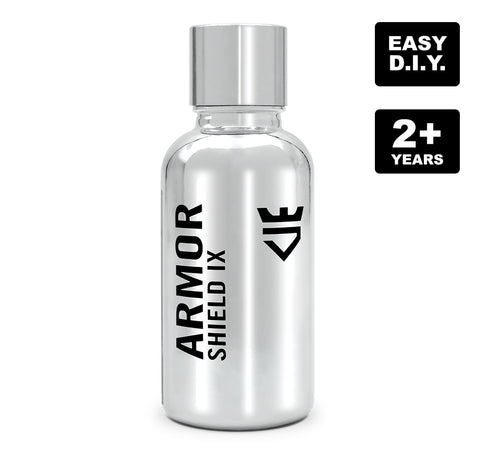
Armor Shield IX Diy Ceramic Coating Kit is a comprehensive solution for those who want to take the DIY route in ceramic coating. It provides a glossy shine, makes the surface easier to clean, and repels water better than waxed surfaces. It's a complete kit with clear instructions and a two-year guarantee.
Benefits:
- Professional-grade ceramic coating at home.
- Ensures protection against environmental factors.
- Easy application, lasting Results.
- Durable shine and hydrophobic magic.
- Two-year guarantee.
2. Armor Shield IX Max DIY Ceramic Coating Kit
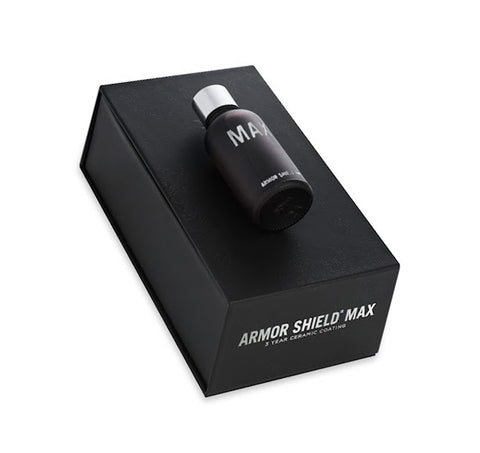
Armor Shield IX Max Diy Ceramic Coating Kit is an upgrade to the regular DIY kit. It offers the same benefits but is designed for larger vehicles, has longer durability, and is twice as hydrophobic. If you're looking for a ceramic coating solution that delivers professional-grade results at home, this kit is worth considering.
Benefits:
- Repels contaminants, UV rays, and environmental factors.
- Ensures your vehicle stays shielded in various conditions.
- Two times more water repellency than the standard kit.
- Three years of guaranteed protection.
3. Psycho - Ceramic Detail Spray
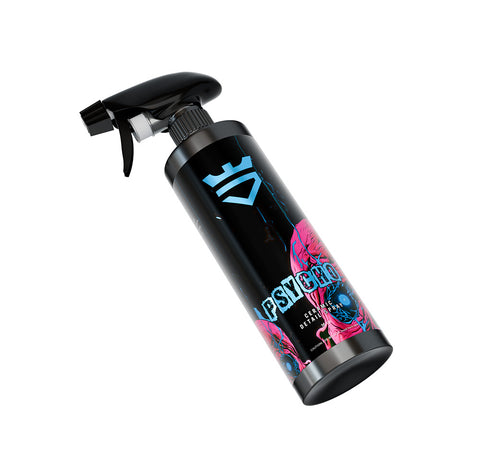
Psycho is a quick and easy solution for maintaining the shine and protecting your ceramic coating. It is a ceramic detail spray that enhances the hydrophobic properties of your coating, making your car easier to clean and maintain. It's the perfect product for topping up the ceramic coating of your vehicle.
Benefits:
- Comes as a spray for easy application.
- Just spray and wipe. No need for prepping or curing.
- Apply to all surfaces, wet or dry.
- It is ultra-hydrophobic and lasts up to six months.
- Perfect for topping up ceramic coatings.
4. Armor Shield Lite
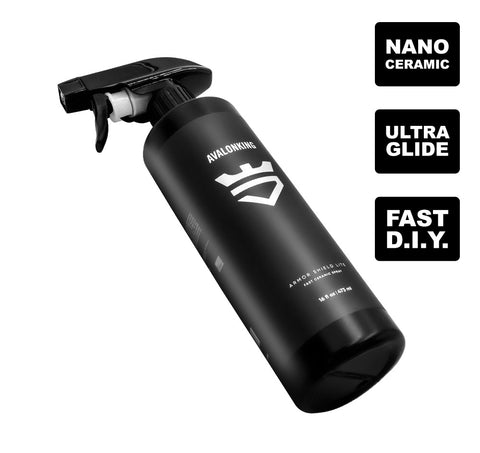
Armor Shield Lite is a spray ceramic coating that offers a cheaper and lighter yet effective layer of protection compared to Armor Shield IX. It's easy to apply and, at the same time, buffs out quickly, making it an excellent choice for those who want a simple and quick ceramic coating solution.
It can be applied while your vehicle is still wet and forms a glossy protective layer to protect against scratches, dirt, and water.
Benefits:
- Inexpensive and easy to use.
- Easy to use with no smearing.
- It can be applied right after a car wash.
- Suitable for instant on-the-go application.
Which Ceramic Coating is the Best?
In the world of automotive care, finding the best ceramic coating is crucial to ensure long-lasting protection and a brand-new look.
Choosing the best ceramic coating depends on your specific needs and preferences. Whether you prioritize ease of application, longevity, or high-gloss aesthetics, the market offers a range of top-notch options.
If you are a DIY enthusiast or a ceramic coating professional looking for a detailed vehicle coating, the Armor Shield IX and Armor Shield IX Max are your best bets.
If your vehicle already has a ceramic coating for a while and you want to top it up, or you want an easy-to-apply option, the Psycho Ceramic Spray is your go-to option. Meanwhile, if you want a low-budget, on-the-go solution, pick up the Armor Shield Lite.
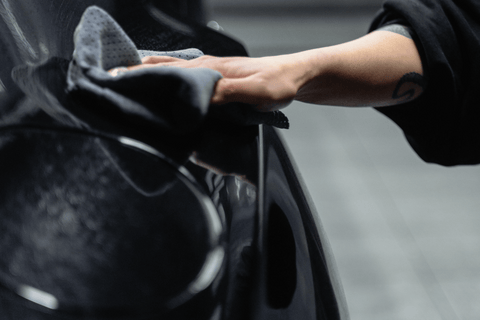
How to Maintain Ceramic Coating
To maintain a ceramic coating and ensure it lasts as long as possible, follow these guidelines:
- Regular Washing: Wash your vehicle every two weeks, ideally. Use a pH-neutral shampoo not to weaken the coating's hydrophobic properties.
- Avoid Washing in Direct Sunlight: Washing your car under direct sunlight or high temperatures can cause water to evaporate quickly, potentially leaving water spots.
- Use a Proper Washing Brush: The material of the brush used to wash your car plays a significant role in maintaining the coating, so it is best to use a softer brush.
- Avoid Automatic Car Washes: The polishing brushes can harm the coating's integrity.
- Dry After Washing: Use a soft microfiber towel to dry your car to prevent water spots from minerals left behind as water evaporates.
- Use a Ceramic Coating Booster: Depending on your ceramic coating, you can use a product like Psycho Detail Spray periodically to enhance the coating's hydrophobic properties and protect the surface.
- Maintenance: Giving your coating a seasonal check every 3-4 months will ensure maximum performance and long-term durability.
- Remove Contaminants Quickly: Bird droppings and tree sap can be acidic and may damage the coating over the long term. So keep an eye out for that.

Regular Washing Techniques and Products
Regular washing is critical to maintaining the look and durability of your ceramic coating. Here are some helpful tips:
1. Pre-rinse- Use a pressure washer or hose to remove loose dirt. Avoid high pressure on the paint.
- Use a pH-neutral car shampoo to protect car wax or sealants.
- Choose a large, soft wash mitt made of microfiber to lift and trap dirt.
- Follow the two-bucket method: one for your soapy water and another for clean water to rinse your mitt.
- Wash in sections, starting from the top and moving downwards.Rinse the mitt frequently to avoid scratching.
- After a wash, rinse the vehicle thoroughly with clean water to remove all soap residue.
- Ideally, wash your vehicle every week or after a long drive.

Drying Methods to Avoid Water Spotting
Water spots can form when you wash your car in direct sunlight, as the water evaporates quickly. Here are some tips to avoid water spotting:
1. Use Microfiber Towels- Use clean, plush microfiber towels to dry your vehicle. They are gentle and highly absorbent.
- Blot drying is preferable to wiping, which can cause micro-scratches.
- Quick detailer sprays or drying aids can help reduce friction and prevent water spots.
- Dry the car immediately after washing to prevent water from air-drying, which causes spots.
- Start from the top and move towards the rear end.
- Dry your car under a shade or in the garage.
- Don't dry your vehicle under direct sunlight. Heat accelerates water evaporation, increasing the likelihood of spots.
- Installing a water filter on your hose can help minimize mineral deposits.
- Prevent your vehicle from scorching direct sunlight. Heat accelerates water evaporation, increasing the likelihood of spots.

Touch-Up Procedures for Scratches or Damage
If your ceramic coating gets scratched or damaged, you can use a few methods to repair it. Here are some tips:
1. Assessing the Damage
- Determine the depth of the scratch - if it is in the clear coat, it can be easily buffed out.
2. Thorough Cleaning
- Before getting started with the damage repair, it is necessary to clear the area thoroughly.
3. Use Scratch Repair Kits
- You can use a scratch repair kit matching your car's paint color for minor scratches.
- Such kits often come with precise instructions, follow them, and you are all set!
4. Proper Polishing
- Minor or major - all touch-ups must be followed up with the polishing.
5. Waxing
- You will also need to apply a coat of wax over the repaired surface to seal and protect the area.
6. Seeking Professional Assistance
- In case of major/deeper scratches, it is often best to seek professional help to ensure a perfect match and durable results.
7. Conduct Regular Maintenance
- Regular waxing and paint protectants can prevent new scratches and other damage.
8. Careful Sanding
- Light sanding may sometimes be required before touching up; however, this should be left to professionals to avoid further damage.

Quick Questions About Ceramic Coating Wheels
Here are some common queries that most car owners have about ceramic coating.
Should I Ceramic Coat My Wheels?
Ceramic coating is the way to go if you want a long-lasting solution to wheel corrosion and make them more appealing. It would be easier on your wallet and eyes!
Is Ceramic Coating On Wheels Worth It?
Yes, it is totally worth it. Ceramic coating is a more financially logical option if you add all the money you would have to spend repainting and repairing your wheels.
How Long Does Ceramic Coating Last On Wheels?
On average, it can last for a year. However, if you get the best ceramic coating for your wheels, you can further extend it to another.

Why Armor Shield IX Ceramic Coating is the Best
If you are still debating whether to choose Armor Sheild IX, here are some reasons to further support its superiority.
A Shine That Protects Your Wheels
Its wet mirror-like shine will make you reignite your love for your car. Moreover, its state-of-the-art composition will protect your car’s wheels from wearing too quickly. This beauty may look delicate, but it’s resilient.
Ease of Application and Longevity of Results
Applying Armor Sheild IX is so easy that you can get it done in your garage. All you will need is an Armor Sheild IX DIY kit and a couple of hours to spare.
The results will not just blow your mind but also survive the test of time. Once the ceramic is set, you can drive your car guaranteed for two long years without any worry.
Compatibility With Different Types of Wheel Materials
Your car wheels can be powder-coated, made of carbon fiber, or covered in chrome. This ceramic coating would bond effortlessly.
Moreover, its nano ceramic coating forms an even layer over the wheels, providing it with much-needed protection.
Cost and Value For Money
A professional ceramic coating session can cost around $500-$3000. However, with Armor Sheild IX, you spend substantially less without compromising quality.
Add the fact that you would only have to worry about it once every 2-3 years, and you have yourself the best deal.
Ceramic Coating vs Wax

While wax may add a lustrous level of shine to a car’s paintwork, it falls short in both staying hard for prolonged periods of time. Yes, we know it may sound like an erectile dysfunction infomercial, but natural carnauba, spray waxes, and ceramic waxes only for a while before they go limp. Simply put, the protective layer they provide is not nearly as permanent as a true ceramic coating, and will not protect surfaces from things like scratches and falcon feces.
While the up-front cost of a DIY ceramic coating may be more expensive than the average car wax, the superior levels of protection it offers are clear. Factor in the amount of time and money spent on stripping and reapplying car wax every month, and a ceramic coating’s benefits become even more obvious.
Further Reading:
Common Ceramic Coating Myths

Myth #1: A Ceramic Coat Will Make a Car Bulletproof
The varying levels of hardness associated with automotive ceramic coating products are all registered on a numbered scale, just like our neighbor’s parole officer visitation days. While people are quick to associate these numbers with the MOHS (mineral hardness scale), all ceramic car coating products are tested on the common pencil hardness scale. Therefore, a 9H ceramic coat rating does not correlate to nearly diamond level hardness levels, but the amount of pressure the coating can withstand before a mark or line can be seen.
While this may do jack-shit to protect your car’s hood from that boulder that just fell out of the bed of the dump truck in front of you, it can help in other areas. 9H hardness levels do wonders for preventing small scratches, scuffs, swirl marks, and road debris from cutting into, or embedding into clear coat.
Myth #2: A Ceramic Nano Coating Doesn’t Need Maintenance
Despite having superior hardness and water repelling properties, the average ceramic paint coating still needs to be cleaned regularly. So while you may not be able to prevent road grime, pollen, avian fecal matter, and various other contaminants from caking onto your car, at least there is a way to make clean-up far less frequent and labor-intensive.
Myth #3: A Ceramic Paint Coating is Permanent
Although a ceramic coating forms a semi-permanent bond with a vehicle’s paintwork, glass, plastic, or clear coat, this sacrificial layer is by no means an indestructible coat of armor. Over time, the molecular structure of even the hardest 9H-rated ceramic coating will begin to deteriorate, at which point it is best to strip the coat entirely, and reapply a fresh layer. That said, a well-made ceramic coating product typically provides 2 years worth of protection at the bare minimum, especially when properly applied and cared for by the consumer.
Still not sure whether ceramic coating is right for your ride? AvalonKing’s Armor Shield IX ceramic coating DIY kit currently has a 4.8/5 positive rating score after 1,800+ reviews, and offers a 2-year guarantee with every kit, all for just $69.99.
Myth #4: Ceramic Coating is Easy to Apply
While DIY ceramic coating kits feature an application process that is relatively easy, the amount of prep time required prior to installation is quite time consuming. Surface blemishes, clear coat oxidation, and paint correction must all be attended to ahead of applying a ceramic coating. Remember, once cured, a genuine ceramic coating product will become semi-permanent, so it is best to do your prep work properly the first time to avoid any regrets down the line. Just like marriage prenups…
Myth #5: Ceramic Coatings Hide Imperfections
While ceramic coatings will give a much smoother look to surfaces, they do little to hide things like faded paint, swirl marks, scratches, obscenities scribbled in permanent marker, or any other notable blemish. Regardless as to whether it is attractive or not, what you see on your car’s surface gets locked into place once a ceramic coating cures, therefore making said imperfection all the more noticeable. So be sure to make sure that surface is looking exactly the way you want it to look before locking it semi-permanently in place with a ceramic coating.
Quick Nerd Note: Perhaps the most notable nano ceramic coating benefit, is its water displacing/hydrophobic capabilities. As numerous videos have illustrated in the past, water, and all of the dirt, grime, and mud that come with it bead-up and roll off, leaving the car’s paint almost completely devoid of liquid. So beware of “ceramic” spray-on products that depend heavily on polymers to replicate hydrophobic attributes, for they are notorious for having poor durability and piss-poor longevity.
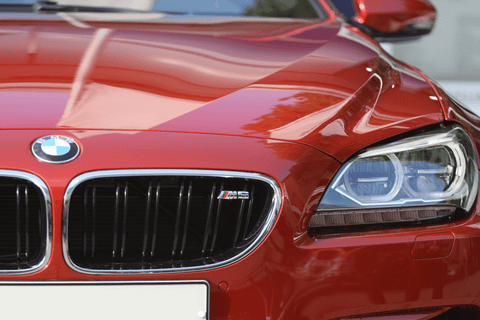
Frequently Asked Questions for Ceramic Coating
How Long Does Ceramic Coating Last When Properly Applied To A Vehicle’s Paintwork?
A professional-grade ceramic coating can last anywhere from two to five years or more, depending on the quality of the product, the preparation of the surface before application, and the maintenance after application. High-end ceramic coatings applied by skilled technicians may even come with a warranty guaranteeing protection for a specific period.
However, no ceramic coating is completely permanent, and it will eventually degrade due to exposure to the elements and normal wear and tear. Regular maintenance, such as washing and avoiding harsh chemicals, can help extend the life of the coating.
While DIY ceramic coating options are available, choosing a high-quality product and having it applied by a professional is recommended for optimal results and longevity.
How Do You Remove Ceramic Coating From A Car?
Removing ceramic coating is rarely as easy as its application, but with the proper tools and a cold six pack, this task can be accomplished in anyone’s garage on a Sunday. But fair warning friends. While a chemical stripper specifically designed for ceramic coating removal may appear to be the easiest route, the acidic nature of these chemicals can cause damage to softer surfaces like tires and door moldings, so proceed with caution.
The best approach is to wait until your car’s ceramic coating is on its last leg, and use a clay bar or clay mitt to scrape away the thin layer residing on the surface. You can also go the paint correction route, and put an approved polishing compound and a power buffer tool to work. Just don’t get carried away, because you might cut into your car’s clear coat.
How Do You Maintain A Ceramic Coating?
The best way to keep a ceramic coated vehicle looking sharp is to regularly hand wash the entire vehicle with water and a pH neutral car shampoo. Make sure that your shampoo does not contain any waxes or sealants either, and use the two-bucket hand washing technique every other week.
Applying a high-quality SiO2 ceramic boost spray to your freshly washed machine every other month will go a long way to boosting the longevity of that ceramic coating as well. This slick, stackable layer rests on top of the existing ceramic coating, and negates the need for removal. Going this route not only significantly extends the life of a DIY ceramic coating, but it also adds additional depth and shine to the paint below.
What Is Ceramic Coating Made Of?
In order for ceramic coating to form a layer of protection on a surface, it must contain the appropriate ingredients in carefully measured amounts. Once this balance has been achieved, the coating can then penetrate all of the microscopic imperfections lurking beneath the surface.
The main ingredient in any true ceramic coating is silica dioxide or SiO2, which as we mentioned earlier, should make-up at least 80% of the formula. However, there is a point where too much SiO2 will turn the ceramic coating viscous, thus making it difficult to apply. A good rule of thumb is to avoid products boasting an SiO2 rating of 85% or above. Other ingredients commonly found in ceramic coatings include titanium dioxide (nano TiO2), activated fluorine, silicon brightening particles, polysilazane, triethanolamine, and water.
How Many Layers Of Ceramic Coating Does A Car Need?
Nano ceramic coatings don’t layer well, so properly applying a ceramic coating to a car’s finish the first time should be all that is needed. The only reason why people tend to coat a vehicle twice, is to guarantee that no areas were missed during the first application.
Can You Apply Wax Over A Ceramic Coating?
Applying car wax to a fresh ceramic coating is like putting vinyl wrap over a $20,000 paint job. It might help protect the coating itself, but it will also negate the hydrophobic properties that make ceramic coating so special. In turn, this will make the vehicle a magnet for all of the contaminants you wish to avoid, so skip the wax, and opt for a ceramic booster instead.
Does Ceramic Coating Protect the Paint?
Yes, ceramic coatings provide a robust and protective surface to a car's paintwork, shielding it from UV rays that can cause fading, chemical stains, and etching from acidic contaminants. It's highly hydrophobic, meaning it repels water, which can carry dirt and grime away from the surface rather than allowing it to stick. It provides excellent protection against contaminants and minor scratches; hence, cleaning the vehicle is much easier.
Is Ceramic Coating Good For Your Car?
Yes, ceramic coating is good for your car. It provides many benefits for car owners, including increased protection against scratches, UV rays, and other environmental damage. It preserves your car's paintwork by keeping it clean and glossy for longer than traditional waxes. It is especially beneficial for those needing a high-quality finish with reduced maintenance.
How Can I Tell if a Car Has Ceramic Coating?
To determine if a car has a ceramic coating, observe how water behaves on the surface — it should bead up and slide off easily if coated. The paint will also have a reflective, glossy appearance. A professional assessment may be required for a definitive answer, as some signs can be subtle. Cars with a ceramic coating usually have a much deeper shine than cars without.
Parting Shots

A ceramic paint coating not only offers rock-hard paint protection, but hydrophobic/water-repellent properties as well. This transparent layer of armor resists UV rays, repels road grime, and prevents scratches, chemicals, extreme heat, and swirl marks from eating into your car’s paintwork. When properly applied and cared for, this semi-permanent ceramic shield will last for years, requiring little more than a quick rinse when dirtied.
If money is of no concern, and protecting your show machine at all costs is the objective, having a professionally installed ceramic car coating applied to your vehicle is the best option. The peace of mind associated with this service, along with the meticulous attention to detail that a trained ceramic coating installation professional provides, offers more benefits than we can mention.
But for most of us, coughing-up a few grand for the installation of a ceramic coating for our daily beater is completely out of the question, leaving the DIY ceramic coating kit as the next best option. And while it may take a bit of elbow grease, and some TLC once installed, the perks to DIY coating a car far outweigh its initial cost and required care.
Still not sure whether ceramic coating is right for your ride? AvalonKing’s Armor Shield IX ceramic coating DIY kit currently has a 4.8/5 positive rating score after 1,800+ reviews, and offers a 2-year guarantee with every kit, all for just $69.99.
If you enjoyed this article, then you'll love AvalonKing's automotive care products for Do-It-Yourselfers. We create "No B.S. products" for an affordable price. And the best part, we treat our customers like family, so if you have any questions or just looking to chat about cars, we're only an email or call away. Check out our homepage here.






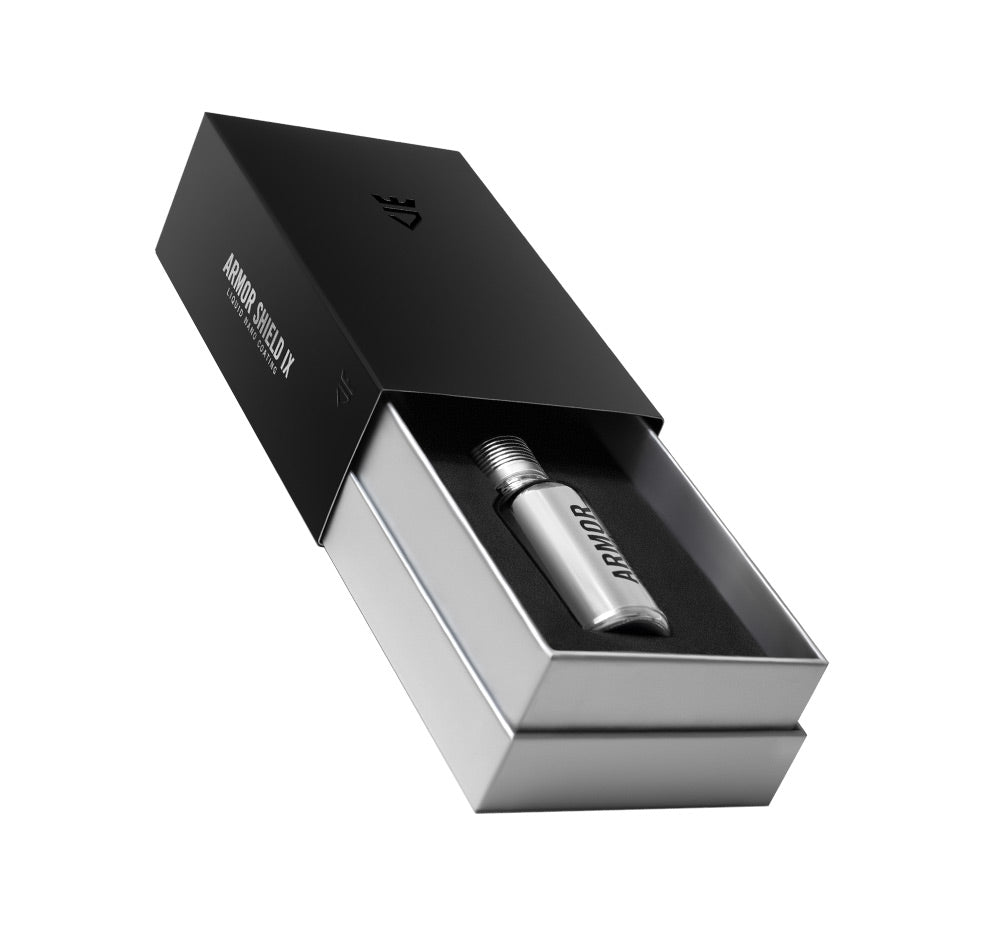
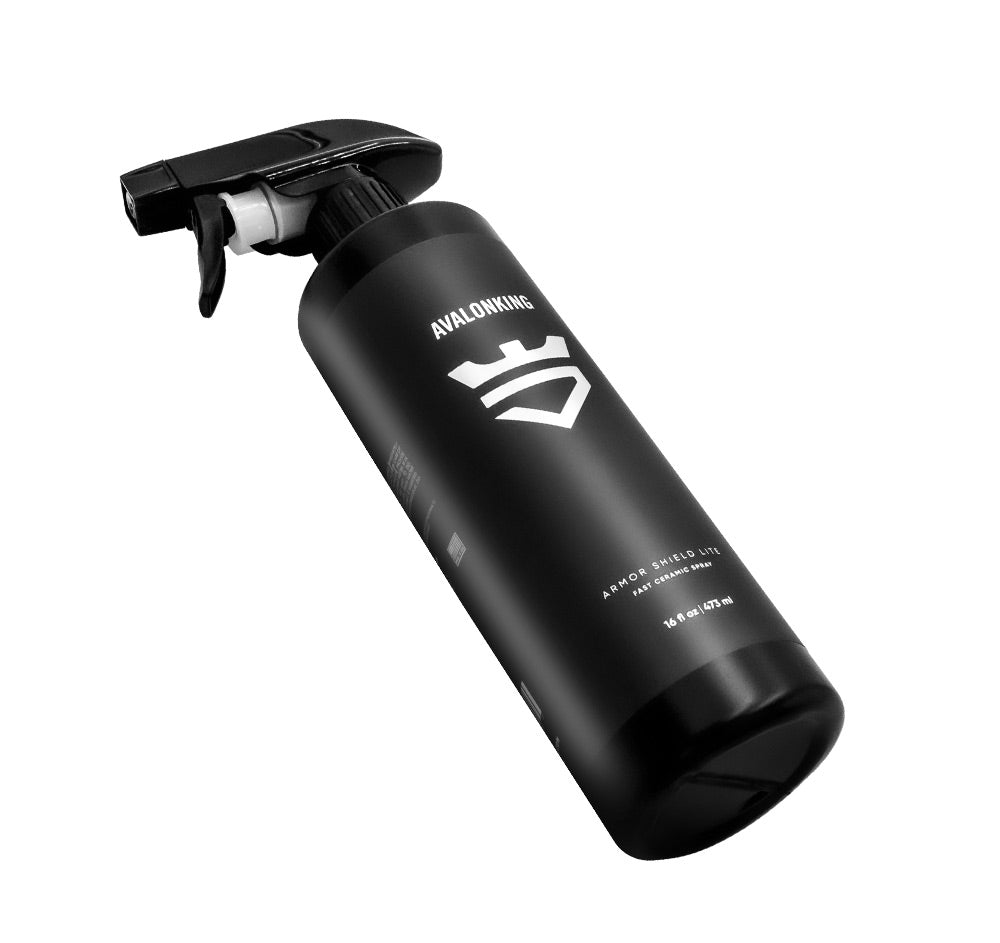


![[2024 Guide] Best Shampoos for Ceramic Coated Cars?](http://avalonking.com/cdn/shop/articles/Beverly-Hills-Car-Wash-scaled-1_1024x.jpg?v=1651076441)
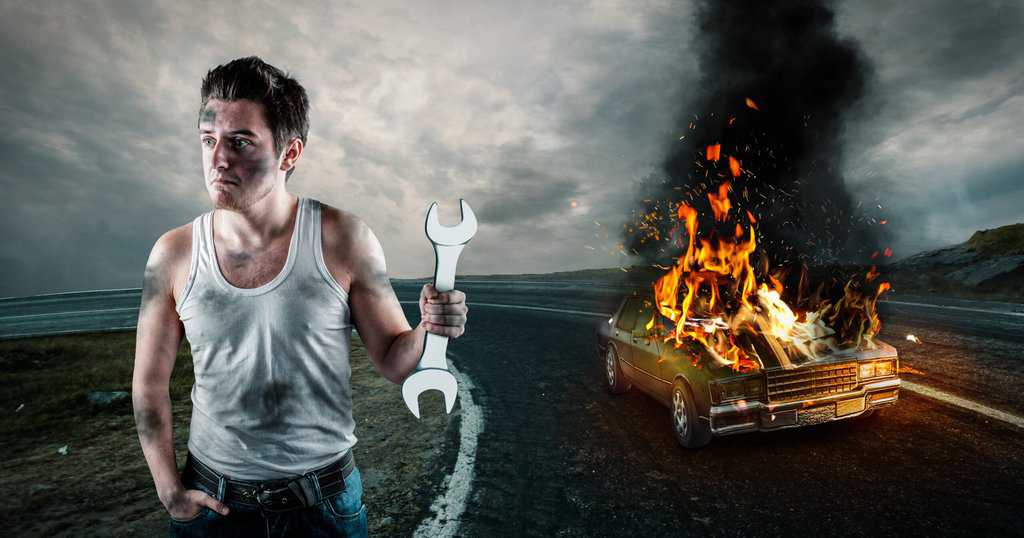

436 comments
Bea
If you have a small potion of your cars top coat coming off, will this fix that and act as they top coat to your paint?
If you have a small potion of your cars top coat coming off, will this fix that and act as they top coat to your paint?
Mike
I just did a ceramic coating (Amour Shield ) on a 2023 Colorado. If I want to do a second coat, how long do I have to wait and what do I have to do before I apply the second coat.
Thanks in advance
Mike
I just did a ceramic coating (Amour Shield ) on a 2023 Colorado. If I want to do a second coat, how long do I have to wait and what do I have to do before I apply the second coat.
Thanks in advance
Mike
Matt
Great info! I just it advertised on the Flying Wheels YouTube channel and he showed how to apply it. It looks very easy to do. I’m gonna give it a shot and see how it works out. It doesn’t seem too difficult for a novice.
Great info! I just it advertised on the Flying Wheels YouTube channel and he showed how to apply it. It looks very easy to do. I’m gonna give it a shot and see how it works out. It doesn’t seem too difficult for a novice.
Dale Pearl
Hi Kyle!
Armor Shield does work great on matte surfaces but to be safe try to test on a small portion first. In most cases, Armor Shield will enhance the matte textures rather than adding shine. The gloss and shine of a ceramic coating come primarily by the mirroring effect! That leads to a tremendous advantage when applied to matte and satin surfaces as it can only enhance what is already there.
Hi Kyle!
Armor Shield does work great on matte surfaces but to be safe try to test on a small portion first. In most cases, Armor Shield will enhance the matte textures rather than adding shine. The gloss and shine of a ceramic coating come primarily by the mirroring effect! That leads to a tremendous advantage when applied to matte and satin surfaces as it can only enhance what is already there.
Kyle Burgess
Is it safe/ok to apply over my entire hood, I have a 2017 Jeep Grand Cherokee Trailhawk that has a matte decal on the hood so wasn’t sure how to approach it? I’ve already purchased 2x kits so can’t wait to get started!
Is it safe/ok to apply over my entire hood, I have a 2017 Jeep Grand Cherokee Trailhawk that has a matte decal on the hood so wasn’t sure how to approach it? I’ve already purchased 2x kits so can’t wait to get started!
Dale Pearl
Hello Casey!
Absolutely! Armor Shield works fine with singe stage paint, surfaces with no clear coat, and even bare metal. The key will be in the prep! We would definitely recommend that a round of polishing as part of the prep phase to help ensure the best long term results!
Hello Casey!
Absolutely! Armor Shield works fine with singe stage paint, surfaces with no clear coat, and even bare metal. The key will be in the prep! We would definitely recommend that a round of polishing as part of the prep phase to help ensure the best long term results!
Casey Jones
Would you recommend this coating for non clear coat paint like farm equipment? I would like to protect my new bobcat and tractor.
Would you recommend this coating for non clear coat paint like farm equipment? I would like to protect my new bobcat and tractor.
Dale Pearl
Hi Joe!
We definitely recommend a round of polishing as a final step of preparation for those that want to achieve the best results! Not 100% essential and many do skip the polishing phase but if you want the very best results that’s the way to go about it.
Hi Joe!
We definitely recommend a round of polishing as a final step of preparation for those that want to achieve the best results! Not 100% essential and many do skip the polishing phase but if you want the very best results that’s the way to go about it.
Joe
Would it be advisable if, before applying Amor Shield, I have the car polished first?
Would it be advisable if, before applying Amor Shield, I have the car polished first?
Tim
Thanks to your blogpost, I decided to get a ceramic coating from nano care on my car. Since I’ve never had any kind of protective coating on my car, I chose professionals to do it. But you have to renew the coating now and then, so I am thinking about doing the next coating on my own. I am really happy with the outcome and can’t imagine my car without the coating anymore.
Thanks to your blogpost, I decided to get a ceramic coating from nano care on my car. Since I’ve never had any kind of protective coating on my car, I chose professionals to do it. But you have to renew the coating now and then, so I am thinking about doing the next coating on my own. I am really happy with the outcome and can’t imagine my car without the coating anymore.